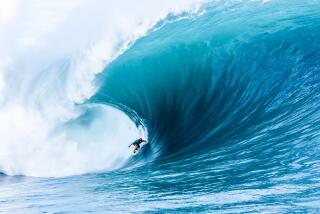Jeantot Organizing a Race Just for Sailors and Sailing
NEWPORT, R.I. — Philippe Jeantot plans to organize a solo, non-stop sailboat race around the world with strict rules against outside assistance for the racers.
Jeantot, overall leader in the last leg of the BOC Challenge solo around-the-world race, has told fellow racers that the new race would start and end in France in 1988.
The rules would prohibit the use of sophisticated (and expensive) weather information radioed from meteorologists on shore. Also, if a racer breaks down, he would be allowed to put into port but must make all repairs himself.
Jeantot is quoted as saying he wants the race to be the ultimate test of sailors, not pocketbooks.
BOC race observers and competitors alike have noted the disparity of resources among the racers.
The French competitors, Jeantot included, have large support staffs who virtually overhaul the boats when in the stopover ports.
One racer commented that Titouan Lamouzou’s Ecureuil Aquitaine was all but rebuilt when it reached Sydney, Australia, the half-way point in the 27,500-mile race.
Many racers, because of limited funds, have no help in the ports other than that given by wives, girlfriends and unpaid volunteers.
Weather information has caused controversy in the current race. The French, including Jeantot, Lamouzou and Jean Yves Terlain on UAP Pour Medicins San Frontiers, have elaborate weather information transmitted to them from France in code. The service reportedly costs each racer up to $3,000 a month.
Some of the recipient boats utilize an on-board computer with a program especially written to utilize the weather information to select optimum courses.
Hal Roth on American Flag protested the access of some to weather information that is not available to all. He told the race committee that it should be given to every boat in the race. His protest got nowhere. The race rules clearly allow individual boats to have special weather arrangements.
Up-to-the-minute weather information has played a crucial role in the race, with those who have it noticeably benefiting over those who don’t.
Racers without tailored meteorological data must rely on standard weather broadcasts with information that often lacks both precision and timeliness. Often, by the time a boat’s skipper gets the information, it is too late to benefit from it.
For example, a routine forecast may report a low-pressure storm cell 200 miles astern and overtaking the boat at 20 knots. That information doesn’t allow a boat sailing at seven knots enough time to alter course to take maximum advantage of the storm’s winds or to minimize its danger.
“More often than not you only have time to reduce sail and duck,” one solo sailor said.
Although details have not been worked out, it is assumed that boats for the nonstop race would be from 40-to-60 feet in length to allow boats in the current event to participate.
Maurice Uguen, who heads Lamouzou’s support crew, is working with Jeantot on organizing the new race.
More to Read
Sign up for Essential California
The most important California stories and recommendations in your inbox every morning.
You may occasionally receive promotional content from the Los Angeles Times.










